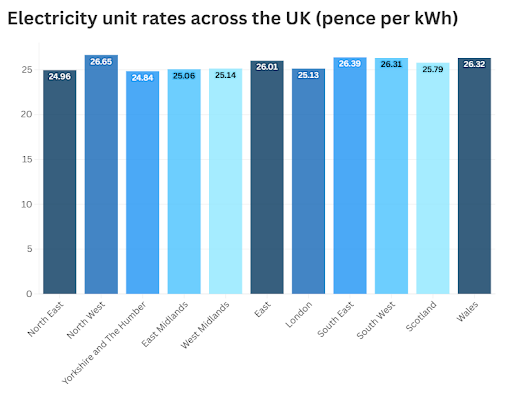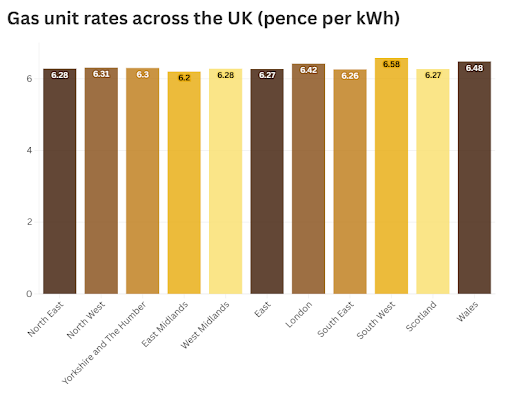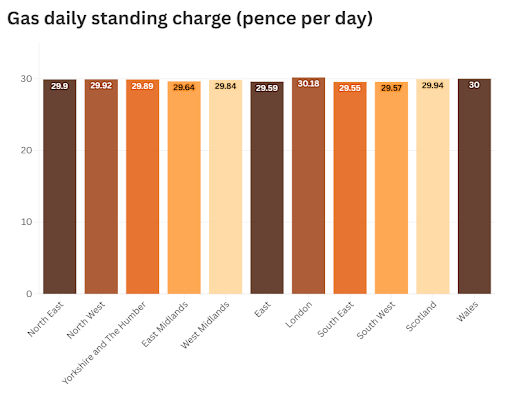We all use the same energy, but we don’t pay the same amount. We’re answering why that is here.
Households across the UK use an average of 2,700 kilowatt hours (kWh) of electricity and around 11,500 kWh of gas every year.
Energy bills however, differ from region to region and despite the fact we all broadly use the same amount of energy, we’re not all paying the same prices. Meaning what it’ll cost you to brew a cuppa will be different according to your postcode.
If you’re wondering why, you’re not alone, which is what we’re going to answer in this article. We’ll also cover how much each UK region pays for gas and electricity, and how you can beat high regional prices.
⚡ Tired of overpaying just because of your postcode?
Energy prices might be rising, but that doesn’t mean your bill has to. With Octopus Energy’s time-of-use tariffs, you can take control - using cheaper, greener energy when demand is low.
🌍 Lower your costs.
🧠 Outsmart peak pricing.
💷 And get £50 credit just for switching.
Ready to join the smart energy crowd? Sign up with Octopus Energy and claim your £50 credit here.
🔑 Key Points:
South West England has the highest gas prices at 6.58 pence per kWh
North Wales & Merseyside has the highest electricity prices at 27.20 pence per kWh
Region energy prices vary because of several factors
You can help beat high regional prices by switching suppliers or installing solar panels
Why Energy Prices Vary by Region
You’d think it’d be much simpler if we just kept energy prices the same across the UK, but it’s unfortunately more complicated than that. Broadly speaking, the main reasons for energy prices varying by region are:
Network/distribution charges
The age and type of grid infrastructure
Local energy supplier competition (of lack thereof)
Climate and heating demand differences
Network/distribution charges
Your area’s distribution network is made up of local distribution network operators (DNOs), who are responsible for distributing energy that keeps the lights on for homes and businesses around the country.
Energy suppliers (who you pay for your gas and electricity) buy energy from DNOs, and different DNOs charge different amounts. Subsequently, what you pay will change according to what region you live in, and what your supplier is paying DNOs for their gas and electricity.
The age and type of grid infrastructure
Sort of like how an old boiler is less efficient and will cost you more than a new boiler, the age and type of a region’s grid infrastructure can affect energy prices.
You see, much of the UK’s grid was designed around coal-fired power stations located near the country’s industrial centres. Renewable energy sources, such as solar farms and wind turbines, are located further away either in rural locations or offshore.
Unfortunately, because the older grid infrastructure still dominates, there’s the problem of power traffic jams, where electricity generated from renewable sources often can’t reach its destination efficiently.
Energy producers are told to switch off their solar farms or wind turbines when the grid is full. And the mad thing is, power plants using fossil fuels are paid to switch on to meet demand. You and everyone else in your region then have to foot the bill to cover the costs.
Local energy supplier competition (or lack thereof)
Living in areas where fewer energy suppliers exist can mean higher prices. With less competition, suppliers might feel less need to lower prices, leaving customers forced to pay whatever the limited number of suppliers choose to charge.
The same is true if you live in an area with a low population – energy costs can be higher because the demand is lower. Densely populated areas can get cheaper energy costs thanks to economies of scale (although, high-population areas such as London don’t always follow this logic).
Climate and heating demand differences
Colder climates lead to increased heating demand in the winter months, which can mean higher energy costs. Or at least it should, because as you’ll see in the table below, many areas in the south of the UK currently have higher gas prices than comparatively colder regions further north.
South West England, for example, pays 6.58 pence per kWh – Northern Scotland pays 6.27 pence per kWh. However, colder regions will invariably use more heating overall, leading to higher heating bills on average.
Energy Price Map: The Highest and Lowest in 2025
Region | Gas unit rate | Gas daily standing charge | Electricity unit rate | Electricity daily standing charge |
North East | 6.28 pence per kWh | 29.90 pence per day | 24.96 pence per kWh | 57.56 pence per day |
North West | 6.31 pence per kWh | 29.92 pence per day | 26.65 pence per kWh | 48.85 pence per day |
Yorkshire and The Humber | 6.30 pence per kWh | 29.89 pence per day | 24.84 pence per kWh | 56.35 pence per day |
East Midlands | 6.20 pence per kWh | 29.64 pence per day | 25.06 pence per kWh | 46.78 pence per day |
West Midlands | 6.28 pence per kWh | 29.84 pence per day | 25.14 pence per kWh | 50.69 pence per day |
East | 6.27 pence per kWh | 29.59 pence per day | 26.01 pence per kWh | 45.94 pence per day |
London | 6.42 pence per kWh | 30.18 pence per day | 25.13 pence per kWh | 43.76 pence per day |
South East | 6.26 pence per kWh | 29.55 pence per day | 26.39 pence per kWh | 45.28 pence per day |
South West | 6.58 pence per kWh | 29.57 pence per day | 26.31 pence per kWh | 51.72 pence per day |
Scotland | 6.27 pence per kWh | 29.94 pence per day | 25.79 pence per kWh | 58.69 pence per day |
Wales | 6.48 pence per kWh | 30.00 pence per day | 26.32 pence per kWh | 49.38 pence per day |
Electricity Costs by Region




The Unfairness Factor: Should Location Matter?
We’ve established that people across the UK pay different amounts for their gas and electricity depending on where they live. If you ask us, this isn’t exactly fair – ordinary British people can’t control where power generation sites will be for example; nor can they control what DNOs charge energy suppliers.
It should be the responsibility of the UK government to increase and invest in more energy efficiency. This includes spending to upgrade grid infrastructure, which is one of the biggest hurdles to energy price parity across the country.
The UK government had actually proposed introducing zonal pricing, until the unpopular plan was abandoned at the beginning of July 2025. It was hoped that zonal pricing would make the energy market more efficient, but there were big concerns that certain regions (particularly the south-east of England) would end up paying much more.
Instead, it’s been argued by opponents to zonal pricing (such as RenewableUK), that the decision to axe zonal pricing is good news for billpayers. Ana Musat, executive director of policy at RenewableUK, said:
“The prices set in the government’s auctions for clean power contracts will be lower than they would have been under the costly zonal pricing regime.”
“It will give confidence to private investors that the UK is one of the best markets in the world to build new renewable energy projects, by ending the uncertainty that zonal pricing would have caused.”
Ways to Beat High Regional Costs
One of the best ways to beat high regional costs is to switch suppliers – particularly to ones that offer flexible or time-of-use tariffs. Getting on a good time-of-use tariff can save you a lot of money on your electricity costs, as long as you’re using electricity during the allotted off-peak times.
You could also adopt smart heating controls, which can save you up to £75 a year according to the Energy Saving Trust. The best element of smart heating is getting much greater control over your heating, such as being able to heat individual rooms. They also have clever features such as ‘geofencing’, which detects when you leave and enter your home and can turn the heating off and on accordingly.
If you have an old boiler, switching to either a heat pump or new boiler can be a great way to save money on high regional energy costs. Heat pumps in particular are incredibly efficient and you’ll save up £260 a year on your energy bills (compared to an old boiler with a G rating for efficiency).
Heat pumps do have a high upfront cost (between £7,000 and £10,000 for an air source heat pump), but you could get a grant worth £7,500 towards the cost of a new heat pump with the Boiler Upgrade Scheme (BUS). If you already have a new boiler, getting a heat pump likely won’t save you money on your energy bills.
Another method for reducing regional costs is to make the switch to solar power. Getting solar panels installed can save you £550–£800 a year (based on a 4 kilowatt peak system and including exports via the Smart Export Guarantee).
Lastly, check to see if you’re eligible for government support. Help to heat schemes could help you upgrade your home’s heating systems to make them more efficient, which’ll reduce your monthly energy costs.
Read more:
Knowledge is Power (and So Is Sunlight)
To summarise, instead of upping sticks and moving to a region with lower energy costs, your best bet is to start making a few changes to your energy habits. There’s loads of small steps you can take to make your home more efficient (check out our guide on improving your EPC rating for top tips), and you’ll start to see your energy bills shrink as a result.
And if you live in one of the UK’s sunniest locations, getting solar panels can be a no-brainer. You’ll reduce your energy bills with solar power while cutting your emissions too – a win for your wallet and the planet!
Get started on saving money with a solar quote from us. Simply answer a few questions about your home, get your fixed price, and arrange your free design. You’ll find out if your postcode is solar-friendly in just a few minutes.
Spoiler alert, even in the cloudiest parts of the UK, solar power is still a fantastic way to generate free, clean electricity.
Read more:
Next Steps For Your Solar Journey:
When planning to install solar panels for your home, there are several important factors to consider. Make sure to refer to the following guides to help you make informed decisions:
To dive deeper into these topics, head over to our advice section, check out our YouTube channel for informative videos, or read a customer case study to see how others have benefited from their solar installation.
Get a Quote for Solar Today
Without boasting you should get your solar installed with us, here's why:
Thousands of Happy Customers: We boast an average score of 4.9 on Trustpilot, outperforming the market leader.
Which? Trusted Trader: Heatable is proudly recognised as a Which? Trusted Trader.
MCS Accredited: Our accreditation by the Microgeneration Certification Scheme (MCS) ensures high-quality standards.
Exclusive Panels: We offer REA Fusion solar panels, available only through Heatable.
Consumer Protection: As members of the HIES consumer code, we provide 2-year deposit protection.
Flexible Payment Options: Choose from multiple payment methods, including finance options.
Fixed Price Guarantee: Enjoy transparency with no hidden costs.
Save Your Quote: You can save your quote and decide later.
Bespoke Design Tool: Draw your own conclusion (literally) on whether solar is worth it for you, here.




